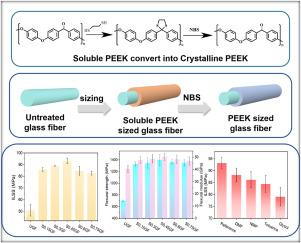The improved interfacial property and solvent resistance of PEEK/GF composites by crystalline PEEK sizing agent
IF 9.8
1区 材料科学
Q1 MATERIALS SCIENCE, COMPOSITES
引用次数: 0
Abstract
The sizing agents of glass fiber are usually epoxy and silane coupling agents, which can't withstand the processing molding temperature of PEEK resin matrix so the interfacial interaction of PEEK matrix and glass fiber is weak. In this work, PEEK polymers with disulfide bonds, which could be converted PEEK structure in mild condition, were synthesized and used as sizing agent of glass fiber to improve the interfacial properties of the glass fiber reinforced poly ether ether ketone (PEEK/GF) composites. The results showed that the interlaminar shear strength increased from 50.96 MPa of unsized GF reinforced PEEK composites (PEEK/UGF) to 93.22 MPa of sized GF reinforced PEEK composites (PEEK/SGF), with an increase of 82.93 %; Due to the improved interfacial properties of the PEEK matrix and GF, the bending strength and modulus of the PEEK/GF composite were increased from 701.30 MPa to 40.34 GPa for PEEK/UGF to 1398.40 MPa and 50.33 GPa for PEEK/SGF, an increase of 99.02 % and 24.76 %, respectively. The mechanism of interfacial enhancement was discussed through the analysis of cross-section morphology. In addition, PEEK sizing agent also had good solvent resistance, which hindered the erosion of organic solvents and the performance retention rate of the composite's ILSS remained above 80 % after PEEK/SGF composites were treated in high temperature organic solvents.

结晶PEEK施胶剂改善了PEEK/GF复合材料的界面性能和耐溶剂性
玻璃纤维的施胶剂通常是环氧树脂和硅烷偶联剂,它们不能承受PEEK树脂基体的加工成型温度,因此PEEK基体与玻璃纤维的界面相互作用较弱。本文合成了具有二硫键的聚醚醚酮聚合物,并将其作为玻璃纤维的施胶剂,以改善玻璃纤维增强聚醚醚酮(PEEK/GF)复合材料的界面性能。结果表明:未施胶的GF增强PEEK复合材料(PEEK/UGF)的层间剪切强度从50.96 MPa提高到施胶的GF增强PEEK复合材料(PEEK/SGF)的93.22 MPa,提高了82.93%;由于PEEK基体与GF的界面性能得到改善,PEEK/GF复合材料的抗弯强度和模量分别从PEEK/UGF的701.30 MPa和40.34 GPa提高到PEEK/SGF的1398.40 MPa和50.33 GPa,分别提高了99.02%和24.76%。通过截面形貌分析,探讨了界面增强的机理。此外,PEEK施胶剂还具有良好的耐溶剂性,阻碍了有机溶剂的侵蚀,PEEK/SGF复合材料在高温有机溶剂中处理后,其ILSS的性能保持率保持在80%以上。
本文章由计算机程序翻译,如有差异,请以英文原文为准。
求助全文
约1分钟内获得全文
求助全文
来源期刊

Composites Science and Technology
工程技术-材料科学:复合
CiteScore
16.20
自引率
9.90%
发文量
611
审稿时长
33 days
期刊介绍:
Composites Science and Technology publishes refereed original articles on the fundamental and applied science of engineering composites. The focus of this journal is on polymeric matrix composites with reinforcements/fillers ranging from nano- to macro-scale. CSTE encourages manuscripts reporting unique, innovative contributions to the physics, chemistry, materials science and applied mechanics aspects of advanced composites.
Besides traditional fiber reinforced composites, novel composites with significant potential for engineering applications are encouraged.
 求助内容:
求助内容: 应助结果提醒方式:
应助结果提醒方式:


